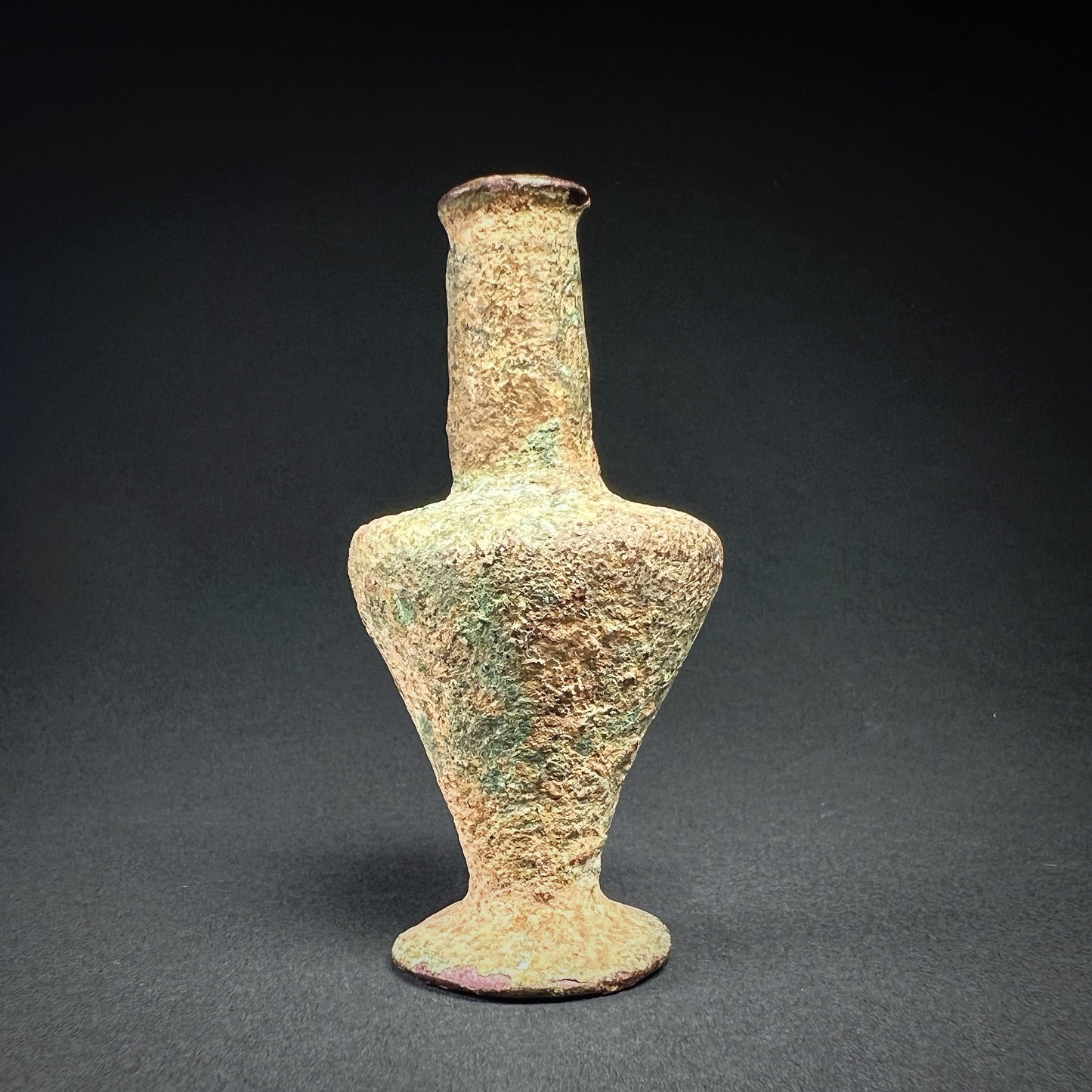Bactrian Bronze Kohl or Cosmetic Container
Bactrian Bronze Kohl or Cosmetic Container
Couldn't load pickup availability
Bactria-Margiana Archaeological Complex, c. 2200–1700 BC, Central Asia
This magnificent and rare Bactrian bronze kohl or cosmetic container, dating from approximately 2200–1700 BC, exemplifies the refined craftsmanship of the Oxus Civilization. Cast using the lost wax technique, this small yet elegant vessel features a conical body, a low foot, a tall neck, and a gracefully splayed rim. Its form is both functional and aesthetically sophisticated, reflecting the high level of metallurgical expertise in the region.
The Bactria-Margiana Archaeological Complex (BMAC), also known as the Oxus Civilization, thrived between 2250 and 1700 BC in what is now northern Afghanistan, southeastern Turkmenistan, and southern Uzbekistan. This Bronze Age society was known for its impressive material culture, including monumental architecture, finely crafted metalwork, and intricate jewelry made from semi-precious stones. The inhabitants were skilled in irrigation farming, cultivating wheat and barley, and engaged in long-distance trade, linking them with Mesopotamia, the Indus Valley, and beyond.
Kohl, the substance for which this vessel was likely intended, has been used since at least 3100 BC, particularly in Egypt, where noble women and queens applied it for both aesthetic and medicinal purposes. Made from stibnite or galena, kohl was believed to protect against eye ailments and shield the wearer from the sun's intense glare. It also held cultural and religious significance across many ancient civilizations. In Islamic tradition, the Prophet Muhammad recommended Ithmid (antimony-based kohl), attributing it with benefits for vision and eyelash growth.
This exquisite bronze container is a remarkable testament to the sophistication of Bactrian artisans. It serves as a tangible connection to the rich traditions of personal adornment and self-care in the ancient world, embodying both the artistic and cultural legacy of one of Central Asia’s most enigmatic early civilizations.
Good condition. Wear consistent with age and use. Surface scratches and corrosion due oxidation. Built up verdigris patina throughout, with rich earthen deposits. Size approx. 7,9cm x 3,7cm x 3,7cm.
Provenance: Danish private collection.
For a similar examples see:
Cosmetic container, The Metropolitan Museum of Art, Accession Number: 1983.535.38 (https://www.metmuseum.org/art/collection/search/326791)
Cosmetic container, The Metropolitan Museum of Art, Accession Number: 1982.445.9 (https://www.metmuseum.org/art/collection/search/326705)
Cosmetic container, The Metropolitan Museum of Art, Accession Number: 1983.535.37 (https://www.metmuseum.org/art/collection/search/326790)
References and further reading:
Margus, Turkmenistan: Ancient oriental kingdom in the old delta of the Murghab river, Wiktor Sarianidi, Publisher Benatzky Druck & Medien, January 1, 2002.
Treasures from the Oxus: The Art and Civilization of Central Asia, Massimo Vidale, Bloomsbury Publishing, 2017.
Thinking Around Grave 3245 in the 'Royal Graveyard' of Gonur (Murghab Delta, Turkmenistan), in: On the Track of Uncovering a Civilisation. A volume in honor of the 80th-anniversary of Victor Sarianidi, Sandro Salvatori, 2010.




-
Shipping
The shipment will be prepared in the course of 3-5 days and dispatched via Posti Group Oyj or purchased item(s) can be picked up from our shop during the store's opening hours (Tarkk’ampujankatu 4, 00140, Helsinki, Finland). Within the Finland, all items are shipped via Posti Group Oyj unless otherwise requested. We pack the items carefully and mainly in recycled materials because we want to save nature. You will receive the tracking number for your items by e-mail.
-
Returns
Returns and exchange will be accepted within fourteen days (14) of receipt at the purchaser’s cost to include freight and packaging. Items must be returned in the same condition as when they were shipped, and will not be accepted if damaged or altered in any way. Please inform us via email (info@gotanmaailma.fi) or by calling +358408408352 before sending. We do not accept returns more than 14 days after delivery.




